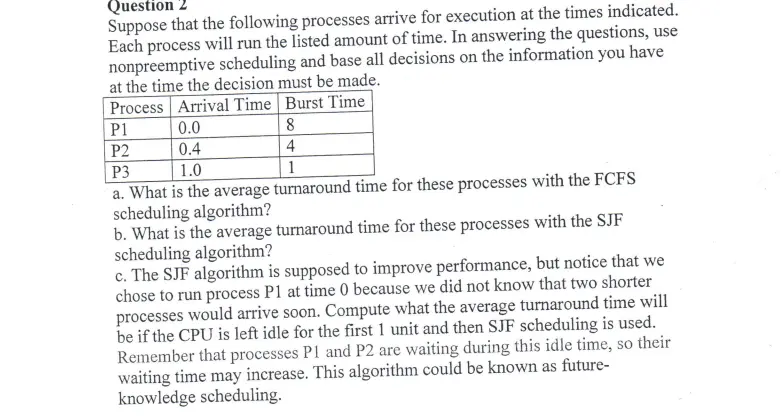Homework Help: Questions and Answers: Suppose that the following processes arrive for execution at the times indicated Each process will run for the amount of time listed. In answering the questions, use nonpreemptive scheduling, and base all decisions on the information you have at the time the decision must be made.

a. What is the average turnaround time for these processes with the FCFS scheduling algorithm?
b. What is the average turnaround time for these processes with the SJF scheduling algorithm?
c. The SJF algorithm is supposed to improve performance but notice that we chose to run process P1 at time 0 because we did not know that two shorter processes would arrive soon. Compute what the average turnaround time will be if the CPU is left idle for the first 1 unit and then SJF scheduling is used. Remember that processes P1 and P2 are waiting during this idle time, so their waiting time may increase. This algorithm could be known as future-knowledge scheduling.
Answer:
Let’s solve this problem step by step to determine the correct answer:
Process Table:
| Process | Arrival Time | Burst Time |
|---|---|---|
| P1 | 0.0 | 8 |
| P2 | 0.4 | 4 |
| P3 | 1.0 | 1 |
a. FCFS (First-Come-First-Serve) Scheduling Algorithm
In FCFS, the process that arrives first is executed first, regardless of the burst time.
Gantt Chart for FCFS:
Process P1 arrives at time 0.0, and since it’s the first process, it starts execution right away.
- P1 starts at time 0 and finishes at time 0+8=8
Process P2 arrives at time 0.4, but since P1 is already running, P2 must wait.
- P2 starts at time 8 and finishes at time 8+4=12
Process P3 arrives at time 1.0, but must wait for both P1 and P2.
- P3 starts at time 12 and finishes at time 12+1=13
Turnaround Time Calculation:
Turnaround time = Completion time – Arrival time
| Process | Arrival Time | Completion Time | Turnaround Time |
|---|---|---|---|
| P1 | 0.0 | 8 | 8−0=8 |
| P2 | 0.4 | 12 | 12−0.4=11.6 |
| P3 | 1.0 | 13 | 13−1=12 |
Average Turnaround Time:
Average Turnaround Time = (8+11.6+12)/3 = 31.6/3 = 10.53
b. SJF (Shortest Job First) Scheduling Algorithm (Non-preemptive)
In SJF, the process with the shortest burst time is selected next.
Gantt Chart for SJF:
1. Process P1 arrives at time 0, so it starts executing first.
- P1 starts at time 0 and finishes at time 0+8=8.
2. Process P2 arrives at time 0.4 and P3 arrives at 1.0, but both must wait for P1 to finish.
- After P1 finishes, P3 (with the shortest burst time) is executed next.
- P3 starts at time 8 and finishes at time 8+1=9.
3. P2 starts after P3 finishes.
- P2 starts at time 9 and finishes at time 9+4=13.
Turnaround Time Calculation:
Turnaround time = Completion time – Arrival time
| Process | Arrival Time | Completion Time | Turnaround Time |
|---|---|---|---|
| P1 | 0.0 | 8 | 8−0=8 |
| P2 | 0.4 | 13 | 13−0.4=12.6 |
| P3 | 1.0 | 9 | 9−1=8 |
Average Turnaround Time:
Average Turnaround Time = (8+12.6+8)/3 = 28.6/3 = 9.53
c. Idle for 1 Unit and then Use SJF Scheduling
The algorithm introduces a delay of 1 unit of idle time and then uses SJF.
Gantt Chart with Idle Time:
1. The CPU is idle for 1 unit of time, so the actual scheduling starts at time 1.
- At time 1, all three processes are available.
2. Since this is SJF, the process with the shortest burst time, P3, will be executed first.
- P3 starts at time 1 and finishes at time 1+1=21 + 1 = 21+1=2.
3. P2 is next since it has the next shortest burst time.
- P2 starts at time 2 and finishes at time 2+4=62 + 4 = 62+4=6.
4. Finally, P1 is executed last.
- P1 starts at time 6 and finishes at time 6+8=146 + 8 = 146+8=14.
Turnaround Time Calculation:
Turnaround time = Completion time – Arrival time
| Process | Arrival Time | Completion Time | Turnaround Time |
|---|---|---|---|
| P1 | 0.0 | 14 | 14−0=14 |
| P2 | 0.4 | 6 | 6−0.4=5.6 |
| P3 | 1.0 | 2 | 2−1=1 |
Average Turnaround Time:
Average Turnaround Time = (14+5.6+1 )/3 = 20.6/3 = 6.87
Conclusion:
(a) Average Turnaround Time with FCFS: 10.53
(b) Average Turnaround Time with SJF: 9.53
(c) Average Turnaround Time with Idle + SJF: 6.87
Learn More: Homework Help
Q. A user generates an image, then asks the model to make further modifications to the same image.
Q. What is the phenomenon called when a camera itself accurately controls the exposure in the image?
Q. Which of the following is a real-world application of algorithms that involves optimizing a process?
Q. How does a GAN network improve its ability to generate better content?